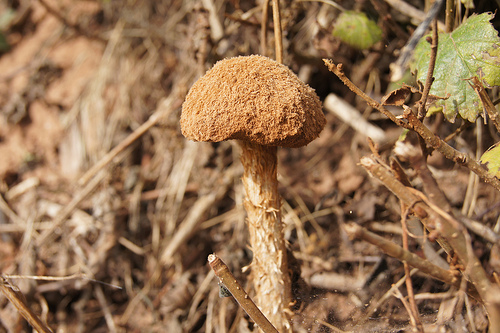Sandy stiltball: Red Data Book of Armenia

Category. EX – Extinct.
Brief description. Fruit body is 5 cm across, at first ovoid, closed, when mature collapses and remains in the lower part of the stipe as volva: mainly under the soil. It has double–layer membrane. Exoperidium is whitish, leather–like, fastly disappearing. Endoperidium is scaly, scaly– fibrous, attached to the woody stipe. When disrupt it is bell–shaped, smooth. Stipe is 15–20 cm long and 1cm thick, hirsute, brown. Capillitium is colourless, consisting of thin filaments. Spore print is rusty. Spores are 4–6 µm, globose, brown or light greyish.
Distribution. Generally in Europe, Asia, America, Southern Caucasus (Azerbaijan, Georgia, Armenia). According to paleontological data it is belongs to the relict species of Cretaceous period. In Armenia it was discovered in Lori floristic region in 1915 – in the surroundings of Akhtala. (Herbarium material was not preserved).
Ecological, biological and phytocenological peculiarities. It can be found on sandy clay soil, sandy soil, in semi–deserts in September on the altitude of 800 m above sea level. Saprotrophic fungi on humus or psammotrophic on sandy.
Main factors of endangering. Disappearance of corresponding biotopes. Data Deficient.
Nature conservation measures. It is necessary to examine extent of occurrence and to discover new biotopes.
Suggestions
 The Ministry of Environment sent a letter international partners to draw their attention to the real danger of environmental disasters as a result of Azerbaijan's large-scale aggression towards the territory of Armenia
The Ministry of Environment sent a letter international partners to draw their attention to the real danger of environmental disasters as a result of Azerbaijan's large-scale aggression towards the territory of Armenia
 Vicia pisiformis: Red Data Book of Armenia
Vicia pisiformis: Red Data Book of Armenia
 Vavilovia formosa: Red Data Book of Armenia
Vavilovia formosa: Red Data Book of Armenia
 Trigonella capitata: Red Data Book of Armenia
Trigonella capitata: Red Data Book of Armenia
 Trigonella astroides: Red Data Book of Armenia
Trigonella astroides: Red Data Book of Armenia












